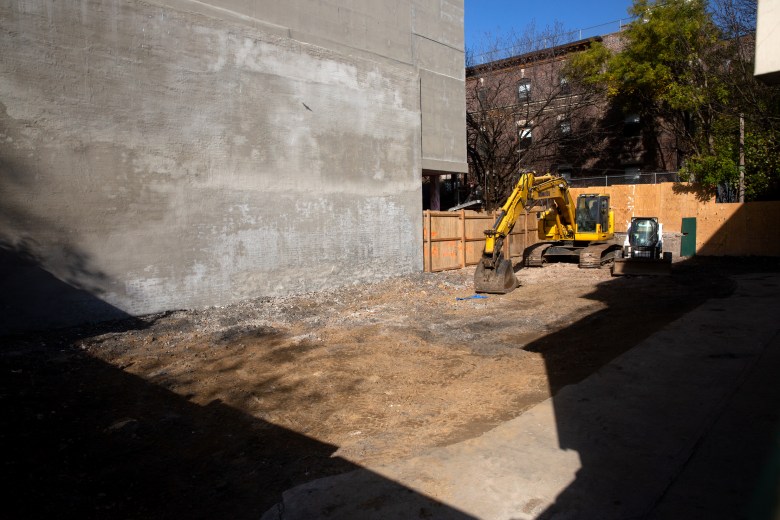After 10 years of advocacy, a residence for people with mental illness who would otherwise be incarcerated for felonies is finally on its way to The Bronx.
Hope House is officially breaking ground Tuesday in Crotona, promising to house 16 people at a time who have conditions such as bipolar disorder or schizophrenia. The Greenburger Center for Social and Criminal Justice, the nonprofit organization sponsoring the project, expects construction to be completed sometime in 2025.
“I want them to be able to leave Hope House and never come back to the criminal justice system again,” said Greenburger Center executive director Cheryl Roberts.
Roberts and Greenburger Center founder Francis Greenburger have nurtured the Hope House idea for years, despite obstacles including a federal ban on using Medicaid dollars for mental-health residences with more than 16 people.
Their $13 million facility will house people who live with serious mental illnesses who have been charged with felony crimes, as an alternative to prison or jail. Evenly split between men and women, the six-year pilot program will house 16 people on Crotona Park North near Marmion Avenue.
One in five people incarcerated on Rikers Island has a serious mental illness, a recent analysis from city Comptroller Brad Lander found.
Alternatives to incarceration or ATIs are already well integrated into New York’s justice system, with the Mayor’s Office for Criminal Justice funding 24 programs run through 14 nonprofit organizations that provide therapy, employment assistance, job training and mentoring and more. While several also help participants find housing, Hope House would be the first residence for people charged with felony crimes.
Residents will have access to therapeutic services, psychiatric counseling and skills training, like cooking, with services run by Argus Community Solutions. They will also be able to enjoy recreational activities and to meet with family.
Residents would stay there for up to two years, a length of time recommended by psychiatrists, according to Roberts. Four beds will be reserved for Bronx residents and those registered as sex offenders will be ineligible, consistent with recommendations from Bronx Community Board 6. The location will also have security on site 24 hours a day.
For a person to be eligible to stay at Hope House, the judge presiding over their felony charge case must order the treatment as part of a plea agreement, and decide how long the individual can stay at the facility based on recommendations from clinicians. The person’s attorney and the district attorney working the case also offer feedback.
People placed in homes there in lieu of a jail or prison sentence would be required to remain on site until they are stabilized, which would generally be at least six months according to Roberts. Medicaid, she noted, typically only pays to stabilize people for 28 days.
“We knew that wasn’t long enough,” said Roberts, “especially with this population.”
‘Leave Better Than When They Came’
“There are going to be a lot of people who are involved in the decision of who will be diverted here,” Greenburger told THE CITY. A literary agent and commercial landlord, he began working to establish a secure facility like Hope House after navigating the system with his son, who has a mental illness and has been incarcerated.
“As I went through the system, I had 20 feet of psychiatric reports. I understand what he did wasn’t great, but let’s send him to a mental health facility,” Greenburger said, recounting something a prosecutor told him: “‘If you bring us a secure facility, we’ll consider it.’ I didn’t realize they sent me on a fool’s errand, because there weren’t any.”
The project is being funded through a combination of Medicaid funding and state aid.
New York State spends $115,000 a year to incarcerate each person in its prisons, according to the Vera Institute. Costs surged even higher in New York City jails during the pandemic, hitting $556,539 per person in 2021 according to an analysis of the Department of Correction by former City Comptroller Scott Stringer.
Roberts said it costs about $125,000 to house each person at Hope House, “which is a lot cheaper in the long run.”
Hope House is in some sense a sequel to the deinstitutionalization movement that began in the 1950s, during which 95% of mental health beds eventually disappeared. What had been 550,000 beds available in the 1950s for people with mental illnesses had been whittled down to fewer than 40,000 by 2016, according to the Treatment Advocacy Center, which advocates for restoring mental health treatment capacity.
Government and private prison operators built one million beds in their absence, Greenburger said.
“We took the mentally ill out of mental hospitals and put them in prisons and thought we’d accomplish something,” Greenburger said. “When you put people with mental illness in jail, they will leave worse than they came in.”
JoAnne Page, executive director for The Fortune Society, an organization that promotes and operates alternatives to incarceration, told THE CITY that “a significant percentage” of their clients have a mental illness and that Hope House is “desperately needed,” explaining how easy it is for a person to be hit with a felony charge.
“If you’re street homeless and mentally ill and you sleep in a doorway, you can be condemned for criminal trespass. If you are homeless and you urinate in public because there’s a dearth of other places to urinate, you are a sex offender if you get arrested,” Page said. “It’s so much a trap that is destructive to the person involved, to their families, to their communities and to the larger community.”
With Hope House, the goal is to improve upon that flawed system.
“The notion here is if they came here, they’re going to leave better than when they came in,” Greenburger said.




